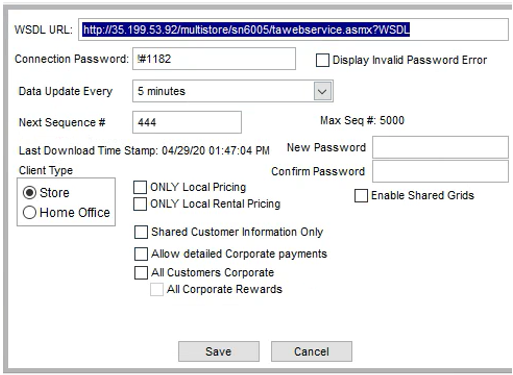Reasons for implementing TransActPOS Multi-Store
Why utilize the Multi-Store functionality of TransActPOS?
-
Seamless integration of Inventory across multiple locations -
Identical SKU listings at each location -
Within the TransActPOS Multi-Store environment, inventory added a store is automatically added to the other stores within the Multi-Store environment. -
Edits to an inventory item are reflected at other store locations automatically. -
Centralized control of Retail Prices between stores -
Retail Price changes are "published" to other stores. The newly published prices are updated by the actions of the receiving store's staff with the process found within IC > Maintenance > Multi-Store Options > Price Print/Update and explained in detail within Retail Price Management within Multi-Store documentation. -
If the receiving store does not follow the "Price Print/Update" instructions, the receiving store's price will not be updated.
-
If the receiving store desires to have their own prices for select items, within the IC > File Maintenance > General tab, the Local Price button will protect the selected SKU from the incoming the "Price Print/Update" process and not update the selected item. If the store desires to accept future price updates found within the "Price Print/Update" process, simply unchecking the Local Price option will allow the next price update to be applied to the SKU. If an immediate price change is desired after unchecking the Local Price option, edit the retail within the IC > Maintenance > General tab and the select Save.
-
Availability of real-time on-hand quantities within the multi-store environment. At any store, the user is presented with a list of store a and their on han -
Ability to transfer Inventory in two different forms -
Direct Inventory transfers to from store through using the IC > Issue feature targeting a destination store. The direct transfer of inventory to a store is restricted to the members of a Security Workgroup that are granted this access. Access to this feature is granted within AO | Wireless HH | Inventory Issue. The process of a Direct Inventory Transfer is explained within IC > Issue Inventory Inter-Store Inventory Transfers -
-
Electronic Catalog Management
-
-
-
-
A Corporate customer is entered at the into the Accounts Receivable > Customer File at the TransActPOS Home Office to include the credit limit and contact list. This customer information is then automatically sent to the associated stores within the multi-store environment. Edits to the customer file from any location automitically updates all locations (Home Office and Stores within the multi-store environment.
-
The corporate customer's credit limit and current net balance is check each time a account charge is attempted within the store. TransActPOS Multi-store automatically contacts the Home Office to collect the current balances of all centrally located invoices and then reports the available credit back to the inquiring store. If the invoice amount does not exceed the calculated available balance, the credit is granted and the invoice is then completed and an invoice is printed and/or emailed to the customer. The newly created invoice is then automatically transferred to the Home Office and added to the customer's balance.
-
-
-
Multi-store environments that want to share inventory and are owned by separate ownership, the "Shared" customer environment is the correct configuration:
-
Customers will receive a statement from each store location.
-
The customer's credit is established at the store and not the home office. Each individual tore maintains the credit limit they desire to have in their unique credit relationship with the customer.
-
Customer information relative to the the customer is shared (updated) between the stores upon a local store's edit of the information. For instance, the change in a customer's address is updated at all locations.
-
Inventory transfers between stores is tracked so that the separate store ownership will be aware of the value of inventory transferred between the stores. The value difference should result in a payment between the stores to settle the value discrepancy - a back office process outside the realm of TransActPOS.
-
Centralized control of core files
-
-
User Groups and Group Security is maintained at the Home office
-
-
Shared Point of Sale and Rental Grid structure
-
This option is turned on within the store's Multi-Store configuration - "Enable Shared Grids"
-
-
-
The Home Office controls the structure of the following areas of the program for consistency of reporting across all locations and the Home Office. -
-
-
-
-
-
-
-
-
-
Vendors are added to the multi-store environment since corporate a credit application would be created for the group of stores. In a shared customer / multiple store ownerships, the vendor creation will continue to be at the Home Office to allow the correct relationship between vendors when the SKU information is distributed between the locations.
|
